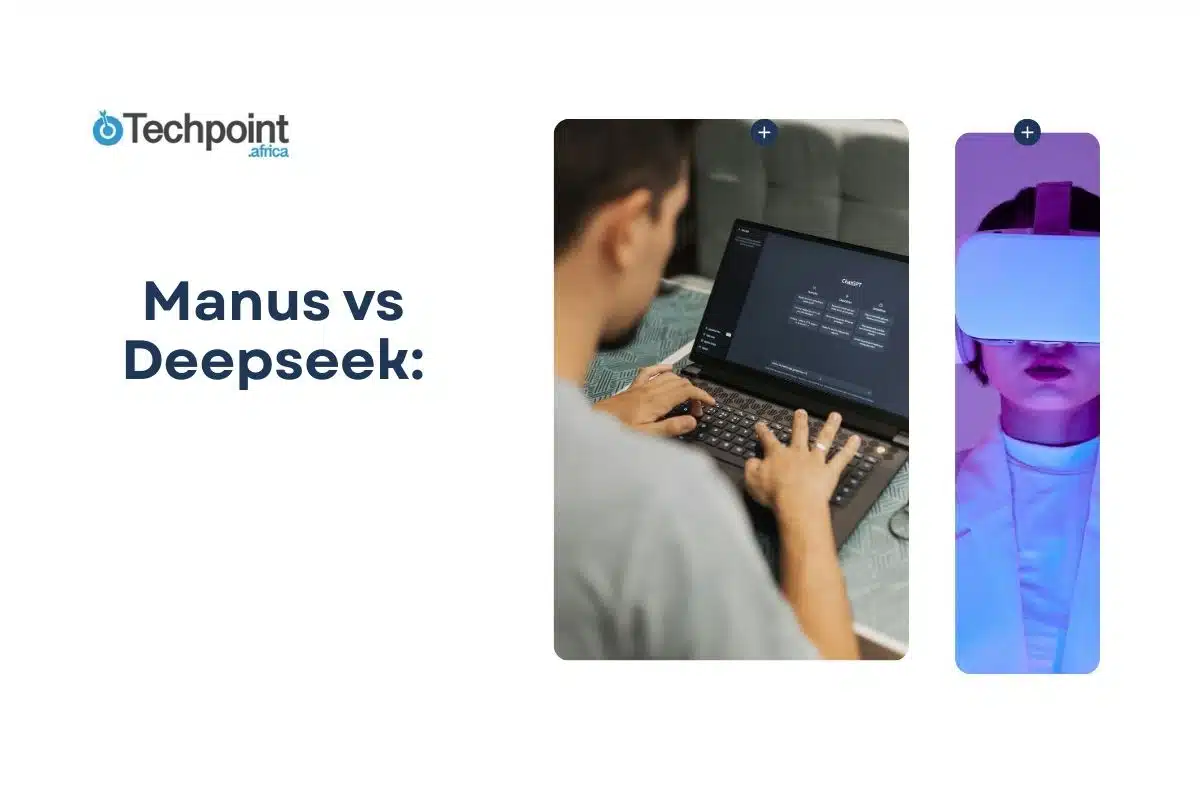Recently, I’ve been experimenting with various AI writing tools to determine which ones actually make a noticeable difference. Manus and Deepseek caught my attention because they both promise to help writers create great content quickly. But I wanted to find out how they really perform when put to the test.
So, I set up seven different writing tasks, everything from simple content creation and technical writing to storytelling and SEO-focused pieces. I wanted to see not just how good the content was, but also how easy the tools were to use.
This article shares my honest experience with Manus and Deepseek. I’ll highlight the strengths of each tool and where they fall short, and help you decide which one might be a better fit for your style and needs. If you’re thinking about trying either of these AI assistants, this comparison will give you a clear picture.
What is Manus?
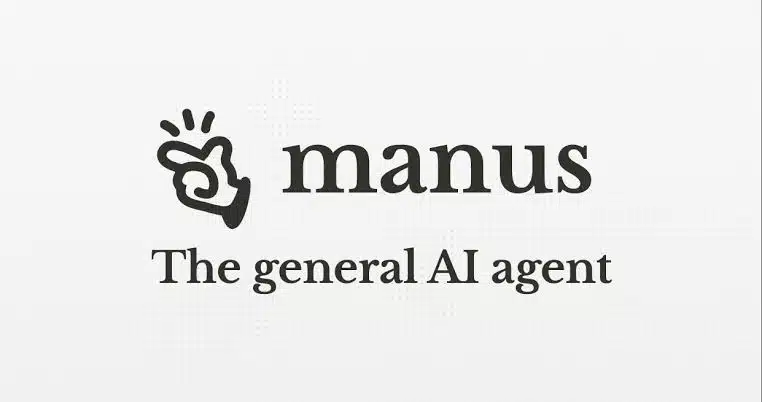
Manus is an AI-powered writing assistant built on advanced natural language processing (NLP) and machine learning models designed to understand context, tone, and intent in user inputs. It leverages cutting-edge deep learning techniques similar to large language models, enabling it to generate human-like, contextually relevant text across a wide range of formats. Manus’s technology focuses on producing content that feels natural and engaging, avoiding robotic or generic outputs.
Manus adapts dynamically to your prompts, learning from user feedback and improving over time. This makes it particularly effective for content creators and marketers who need tailored content that speaks directly to their target audience.
One standout aspect of Manus is its SEO-aware architecture. The tool not only generates content but also actively suggests keyword placement and phrasing to improve search engine visibility without compromising readability. This blend of creativity and technical optimization sets Manus apart for users who want both engaging and high-performing content.
Here’s a closer look at Manus’s core features:
- AI-Powered Content Generation: Uses deep learning models trained on vast datasets to create coherent, relevant, and human-like text for blogs, articles, social media, and more.
- Contextual Rewriting & Paraphrasing: Goes beyond simple synonym swapping by understanding sentence context to rephrase content meaningfully while preserving the original message.
- SEO Optimization Tools: Integrates keyword research and natural keyword insertion features to help improve content ranking on search engines while keeping the copy reader-friendly.
- Tone & Style Customization: Allows users to set specific tones like formal, casual, persuasive, or conversational, helping to align the content with brand voice or audience expectations.
- Pre-built Templates: Offers a wide variety of templates for different content types, accelerating workflow by providing structured starting points for writing projects.
- Collaboration & Workflow Integration: Supports team collaboration with shared workspaces, commenting, and easy export options, fitting into various content workflows.
- Real-Time Feedback & Improvement: Continuously learns from user inputs and corrections to enhance future outputs, making it smarter the more you use it.
Manus combines sophisticated AI technology with practical tools that support the entire writing process. Its focus on contextual understanding and SEO integration makes it a powerful choice for creators who want polished, optimized content without losing a human touch.
What is Deepseek?
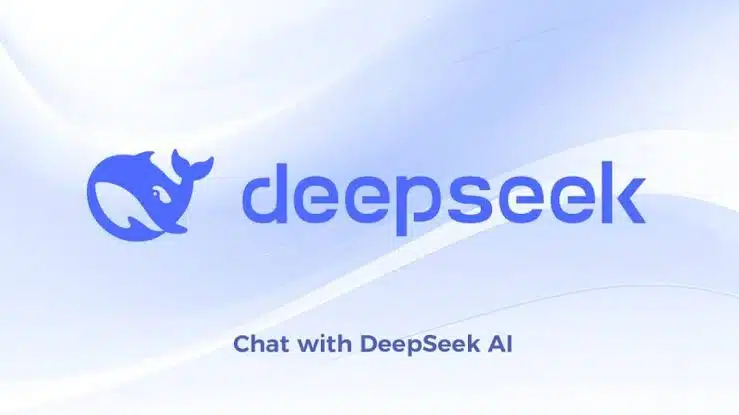
Deepseek is an AI-driven content research and writing assistant that combines advanced natural language understanding with real-time data retrieval to help users create well-informed and accurate content. Unlike many AI writing tools that focus solely on generating text from static training data, Deepseek integrates powerful semantic search technology, enabling it to retrieve relevant information from live sources and databases as part of the writing process.
Deepseek uses deep learning models specialized in contextual analysis and information extraction. This approach enables the tool not just to generate text but to assist users in discovering insights, facts, and up-to-date references that enrich their content. By bridging AI writing with research capabilities, Deepseek caters especially well to writers, bloggers, and professionals working with complex or evolving subject matter where accuracy and freshness are crucial.
Deepseek also emphasizes flexibility and integration, supporting a variety of workflows through APIs and plugins that allow it to work alongside popular writing and publishing platforms.
Here’s a breakdown of Deepseek’s key features:
- Semantic Content Research: Uses AI-powered semantic search to find contextually relevant information, articles, and data points in real-time to support content accuracy and depth.
- AI-Assisted Writing: Generates drafts, suggestions, and completions that incorporate the latest research, helping users produce informed and well-rounded content.
- Integrated Research Workspace: Combines research and writing in a single interface, allowing users to gather notes, references, and sources without switching apps.
- Fact-Checking Support: Highlights and verifies factual information, reducing the risk of errors and misinformation in your writing.
- Customizable Content Templates: Provides templates designed for various content types, with an emphasis on research-driven pieces like whitepapers, technical blogs, and reports.
- Collaboration Tools: Enables teams to work together with shared projects, comments, and version control, ensuring consistency and efficiency.
- API and Plugin Integration: Supports integration with other platforms, enabling users to embed Deepseek’s capabilities into their existing workflows.
- Multilingual Capabilities: Offers support for multiple languages, both in research and content generation, catering to global audiences.
Overall, Deepseek stands out by merging AI writing with dynamic, research-backed content creation. Its focus on real-time data retrieval and verification makes it a go-to choice for anyone who values accuracy and depth alongside creativity.
How i set up the test
To get a well-rounded picture of how Manus and Deepseek perform, I created seven different writing tasks that cover a range of common content needs. These tasks include basic content generation, technical writing, creative storytelling, SEO-focused writing, rewriting and editing, summarization, and multilingual or specialized content.
For fairness, I used the same prompts for both Manus and Deepseek. Each task was approached with similar instructions and expectations, and I gave both tools enough time to generate their outputs without rushing. This way, the comparison reflects how each tool handles identical challenges in real-world scenarios.
Next, I’ll share the results and my observations for each task, so you can see exactly where Manus and Deepseek stand out, and where they fall short.
Task 1: basic content generation
Prompt: Write a 150-word introduction about the benefits of daily exercise, aimed at a general audience, with a friendly and motivational tone.
For this first task, I wanted to test how well Manus and Deepseek generate clear, engaging content with minimal input.
Manus output
The introduction was warm and approachable, opening with a relatable hook about how daily exercise can boost energy and mood. It smoothly covered benefits like improved heart health, stress reduction, and better sleep. What stood out was the natural phrasing.
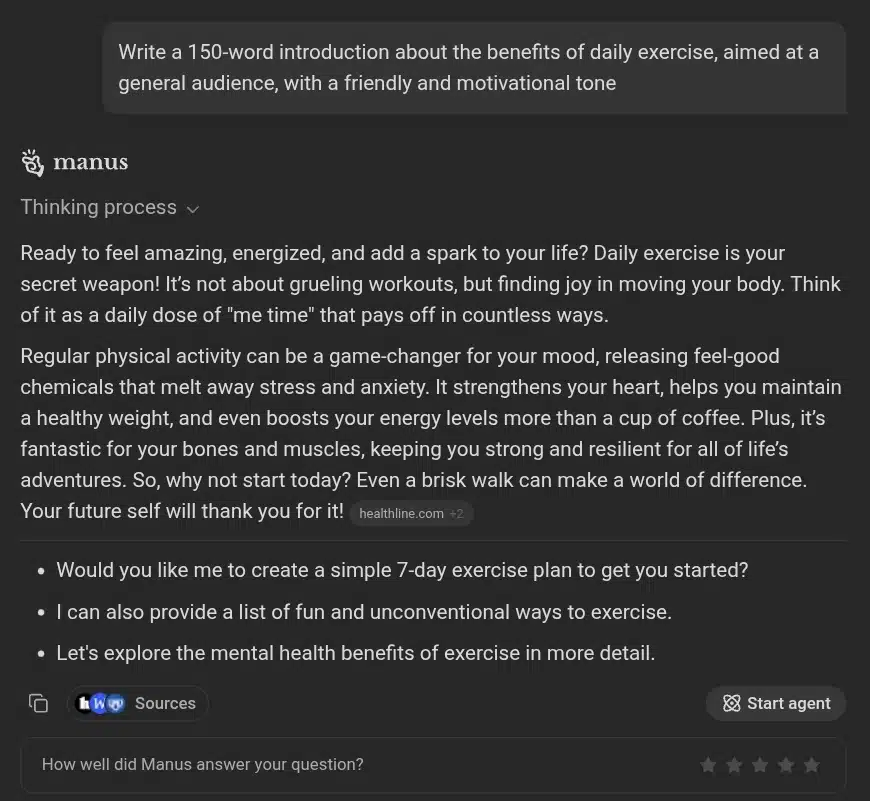
Phrases like “even a brisk walk can make a world of difference” made it feel personal rather than generic. There were no awkward transitions, and the call-to-action encouraging readers to start small felt motivating and well-placed.
Deepseek output
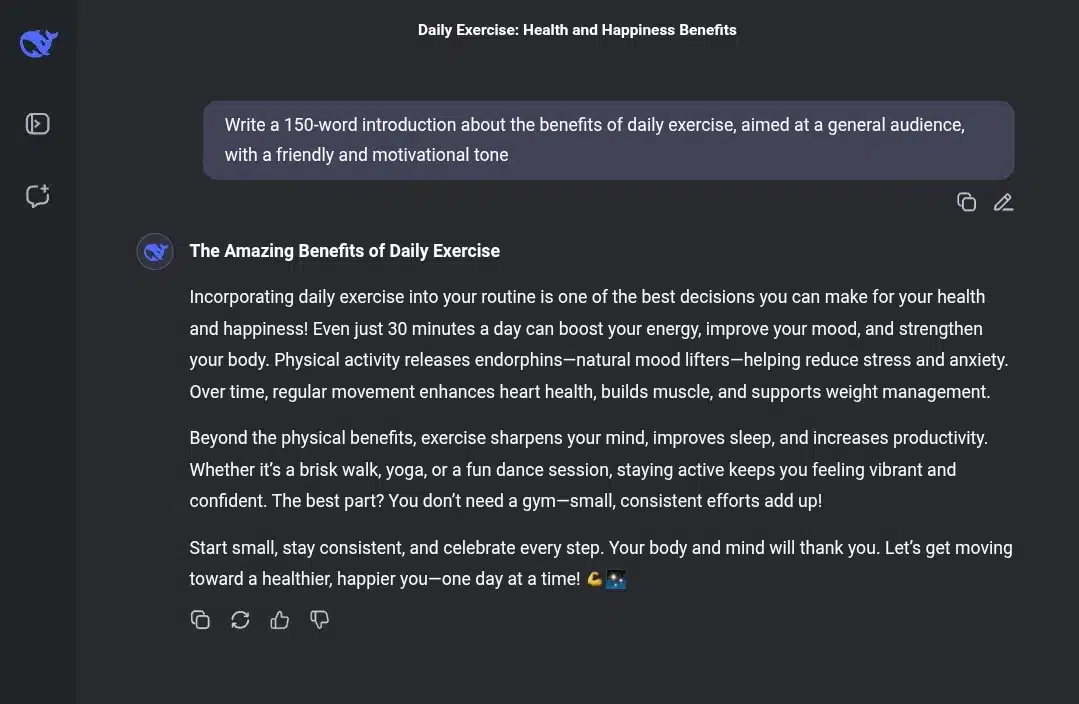
The version was fact-driven, opening with statistics about exercise and longevity. While informative, it came across as more formal and less inviting. Sentences like “incorporating daily exercise into your routine is one of the best decisions you can make for your health and happiness” felt stiff and slightly repetitive. A couple of points, such as the emphasis on cardiovascular benefits, were repeated in different words, which disrupted the flow. It lacked the warmth Manus managed to create.
In terms of workflow, Manus generated the text in about 10 seconds and allowed easy inline edits. Deepseek took roughly 15 seconds, and while it offered fact-checking hints, the interface felt slightly less intuitive for quick tweaks.
Verdict
Manus nailed the friendly, motivational tone better and produced a smoother read for this task. Deepseek’s strength here was accuracy, but its more formal style didn’t fit the prompt’s casual vibe as well.
Task 2: technical writing (product description)
Prompt: Write a 100-word product description for a wireless noise-cancelling headphone, highlighting key features like battery life, sound quality, and comfort.
For this task, I wanted to see how Manus and Deepseek handle clear, concise technical writing that’s still engaging.
Manus output
Manus created a clean, easy-to-understand description that emphasized the headphones’ 30-hour battery life, superior noise-cancelling capabilities, and ergonomic design. It also used straightforward language.
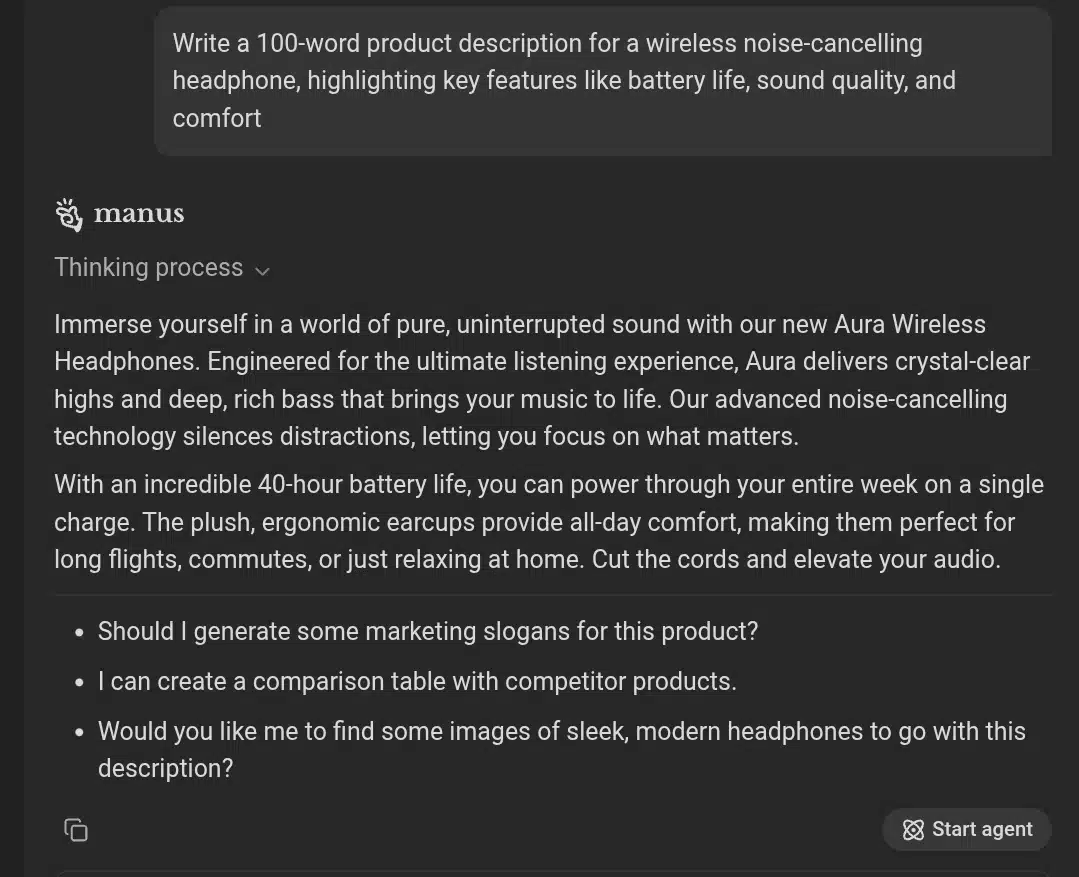
The flow was logical, starting with battery life, moving to sound quality, and ending with comfort. The tone struck a balance between professional and approachable, making it easy to picture the product’s benefits.
Deepseek output
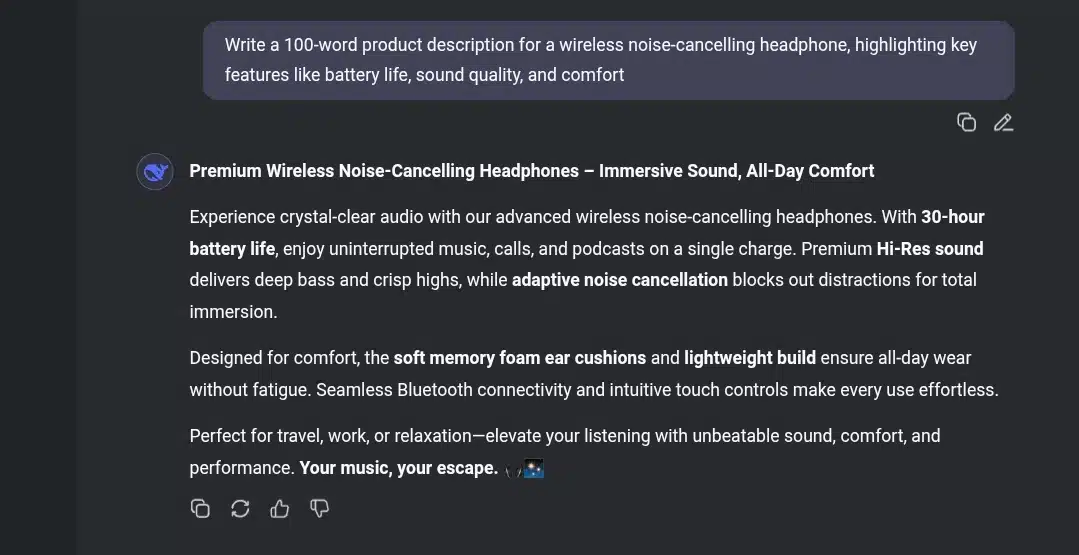
Deepseek’s description was packed with details but felt more like a specs sheet than a marketing copy. It mentioned “advanced noise suppression technology” and “battery endurance up to 30 hours,” which are strong points. However, the description lacked a persuasive touch that would excite potential buyers.
Manus completed the task slightly faster and made it easy to tweak phrases directly in the editor. Deepseek offered additional suggestions to improve factual accuracy but required more manual editing to soften the tone.
Verdict
Manus delivered a product description that balances technical detail with persuasive, user-friendly language. Deepseek provided solid facts but missed the mark on engaging, customer-focused copy.
Task 3: creative writing (short story intro)
Prompt: Write a 150-word introduction to a short story about a lost dog finding its way home.
For this creative task, I wanted to see how Manus and Deepseek handle storytelling, emotion, and vivid imagery.
Manus output
Manus opened with a warm, engaging scene: “The rumble of the garbage truck was the first crack in Buster’s perfect Saturday.” The language was descriptive and emotive, painting a clear picture of the dog’s vulnerability and determination. The narrative flow was smooth, introducing the setting and the dog’s feelings naturally.
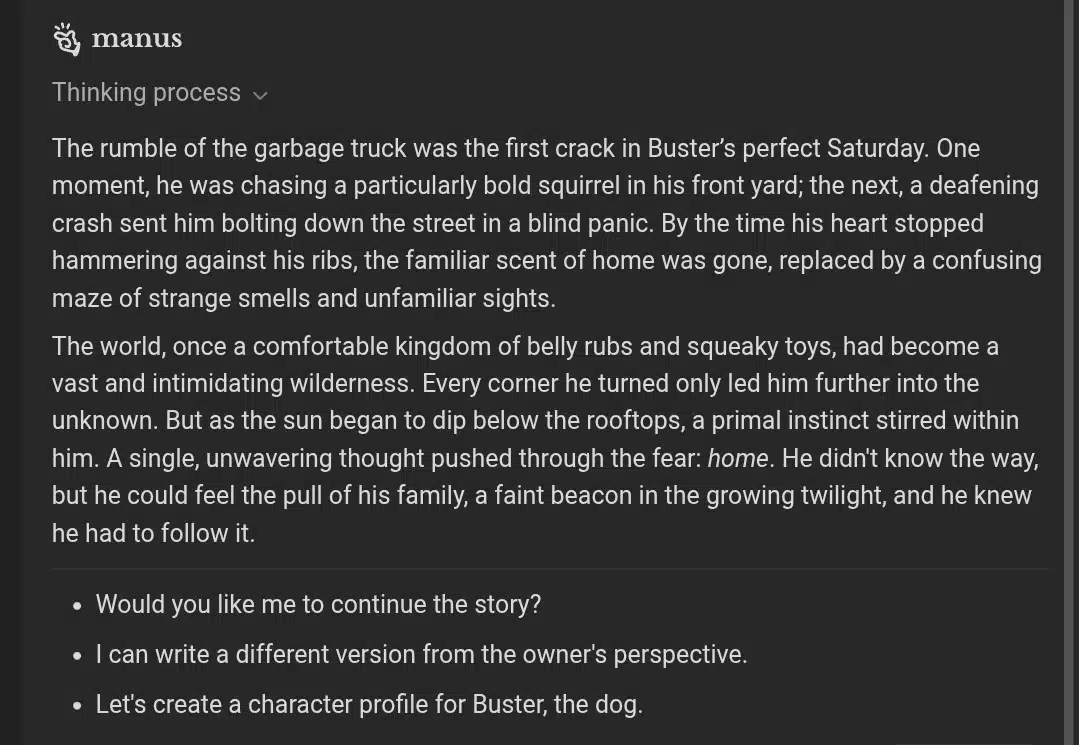
Phrases like “By the time his heart stopped hammering against his ribs, the familiar scent of home was gone, replaced by a confusing maze of strange smells and unfamiliar sights” added depth and connected emotionally. Overall, Manus created a compelling intro that felt like the start of a heartfelt journey.
Deepseek output
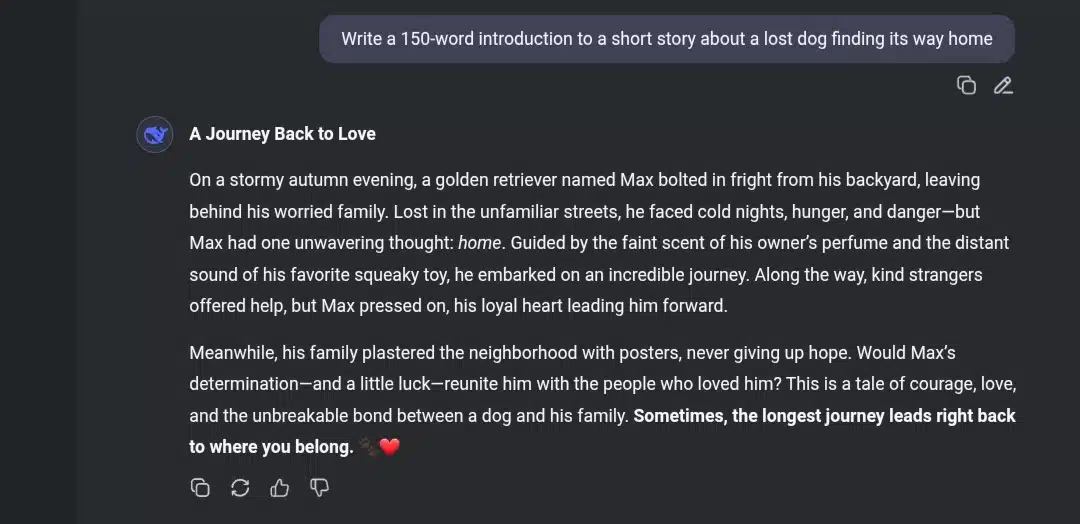
Deepseek’s introduction was more straightforward and functional. It described the dog’s journey with sentences like “a golden retriever named Max bolted in fright from his backyard, leaving behind his worried family.” While clear, it lacked the emotional resonance and sensory detail that Manus delivered. The tone felt more like a summary than an immersive story, and the pacing was slightly abrupt. There was little use of metaphor or vivid imagery.
In terms of editing, Manus’s interface encouraged creative refinement with easy rephrasing options, while Deepseek focused more on factual accuracy, which was less relevant for this task.
Verdict
Manus clearly excelled at creative storytelling, producing an emotionally rich and immersive introduction. Deepseek’s approach was more utilitarian, better suited to fact-based content than fiction.
Task 4: SEO-focused content (blog post intro)
Prompt: Write a 150-word blog post introduction about the benefits of meditation, naturally including the keyword phrase “mindfulness meditation.” The tone should be informative and inviting.
This task tested how well Manus and Deepseek handle SEO writing, balancing keyword integration with reader engagement.
Manus output
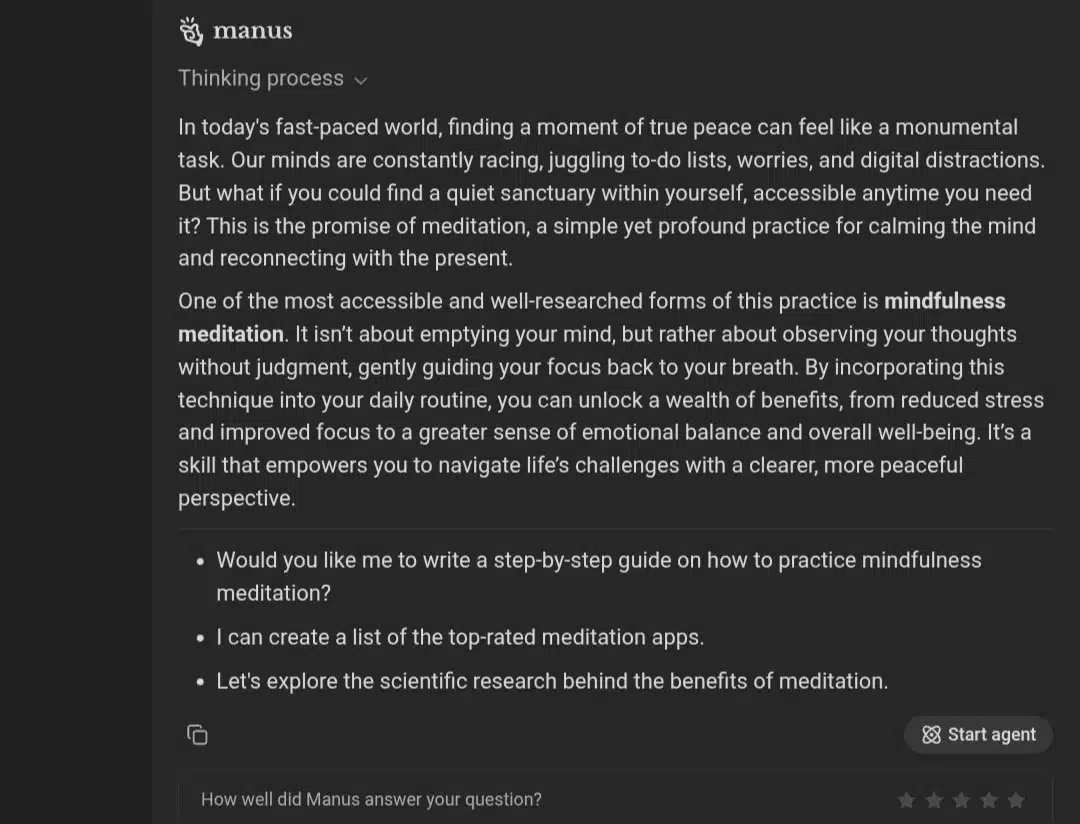
Manus began with a relatable hook about stress in daily life and transitioned into explaining how mindfulness meditation offers relief. The language was clear and accessible, with phrases like “practicing mindfulness meditation regularly can help you stay calm and focused.” The tone was warm and encouraging, making it easy to read and SEO-friendly at the same time.
However, it had the cliche robotic sentence, “in a world where…”
Deepseek output
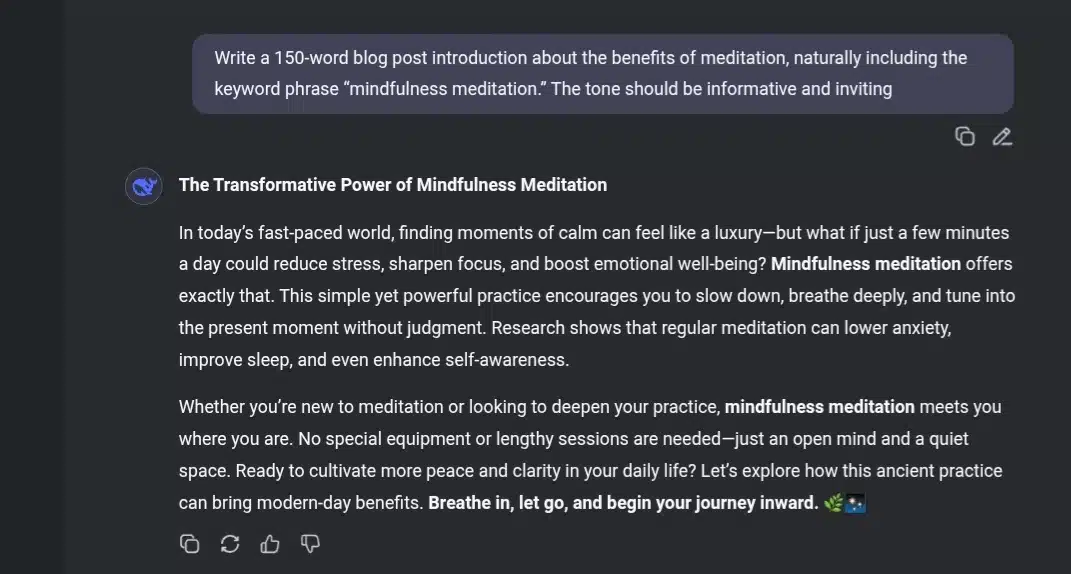
Deepseek also included the keyword phrase but leaned more heavily into factual statements. The introduction contained statistics about meditation’s benefits and referenced scientific studies. While the keyword was well-placed, the text felt more formal and less conversational. Some phrases were accurate but somewhat stiff for an introduction.
Regarding usability, Manus’s editor allowed quick keyword density checks and live editing suggestions, while Deepseek offered fact-check pop-ups but required more manual refinement to improve flow.
Verdict
Manus balanced SEO needs with natural, engaging writing better in this task. Deepseek’s strength was its research-backed accuracy, but at the cost of a less friendly tone.
Task 5: problem-solving (math explanation)
Prompt: Explain step-by-step how to solve the quadratic equation ax2+bx+c=0ax^2 + bx + c = 0 using the quadratic formula.
For this task, I wanted to evaluate how Manus and Deepseek handle clear, logical explanations, especially for technical subjects like math.
Manus output
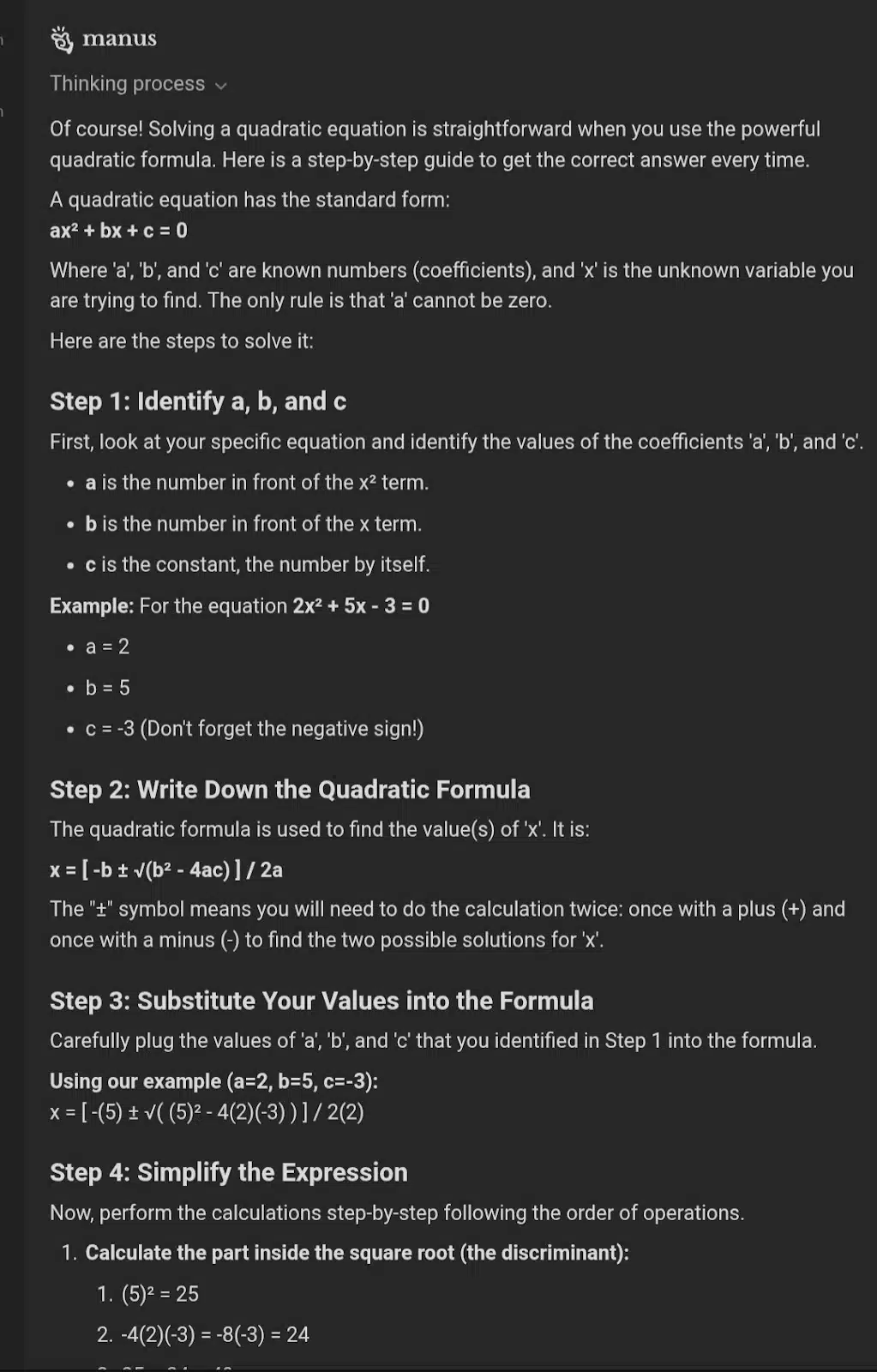
Manus provided a detailed step-by-step explanation, clearly stating the quadratic formula and explaining each part of it. It broke down how to calculate the discriminant, the significance of positive or negative results, and how to find the two solutions for xx. The language was straightforward, making the process easy to follow for readers unfamiliar with the formula. However, it missed showing an example with actual numbers, which would have made the explanation even clearer.
Deepseek output
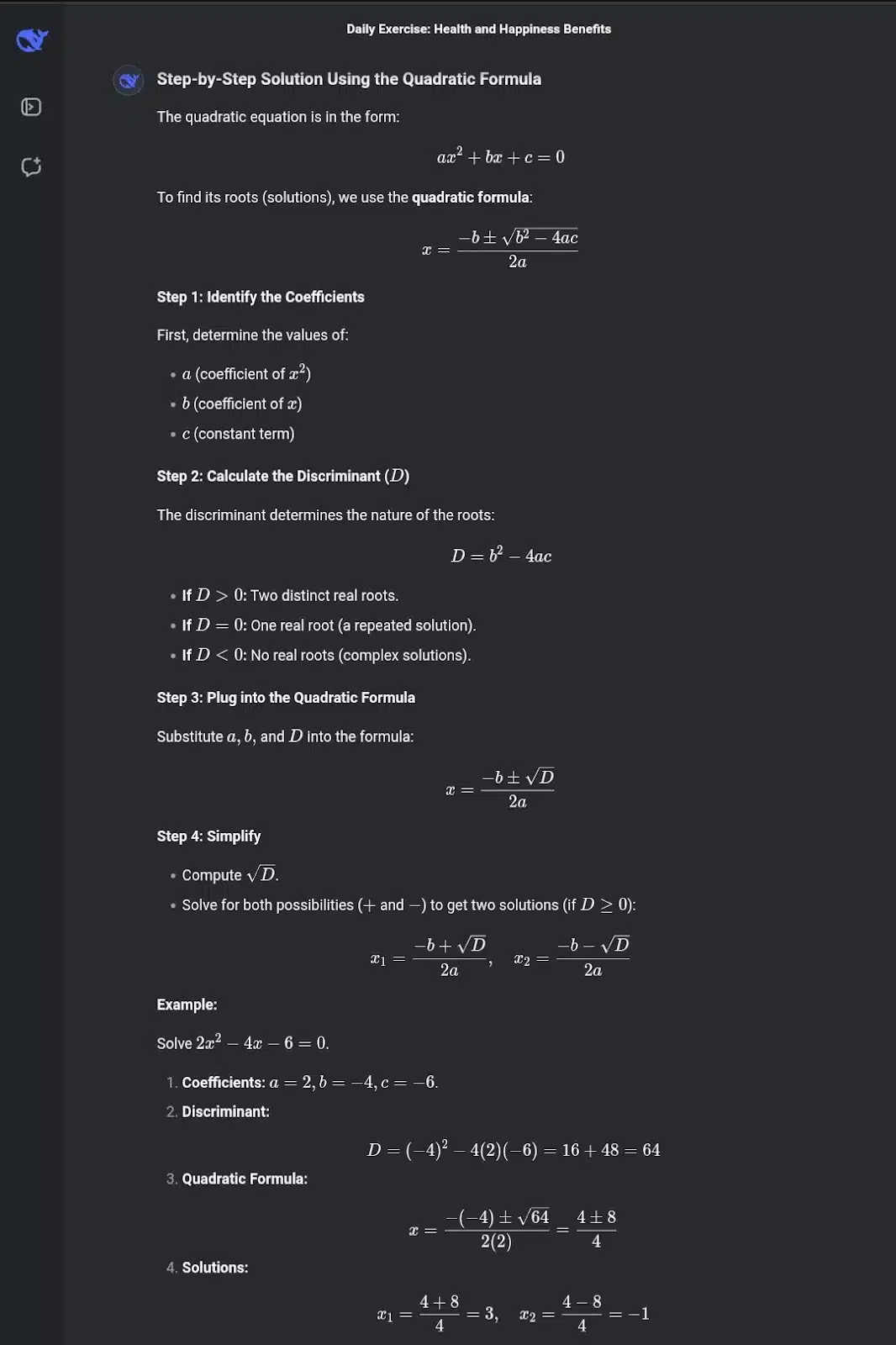
Deepseek’s response was similarly structured but went a step further by including a numeric example solving 2×2+3x−2=02x^2 + 3x – 2 = 0. It detailed every calculation, which helped illustrate the method clearly. The explanation was precise but leaned slightly toward formal academic language, which might be less accessible to beginners.
In terms of usability, Manus was faster in generating the content, but Deepseek’s inclusion of a worked example added practical value for readers looking to understand the process fully.
Verdict
Both tools handled the math explanation well, but Deepseek’s example made the concept more tangible. Manus’s explanation was clear but could benefit from adding practical illustrations.
Task 6: multilingual content (translation and localization)
Prompt: Translate the following English paragraph into Spanish, maintaining a friendly and conversational tone:
“Traveling opens your mind to new experiences and cultures. It challenges your perspectives and helps you grow as a person.”
This task was designed to test how well Manus and Deepseek manage translation accuracy while preserving tone and style in another language.
Manus output
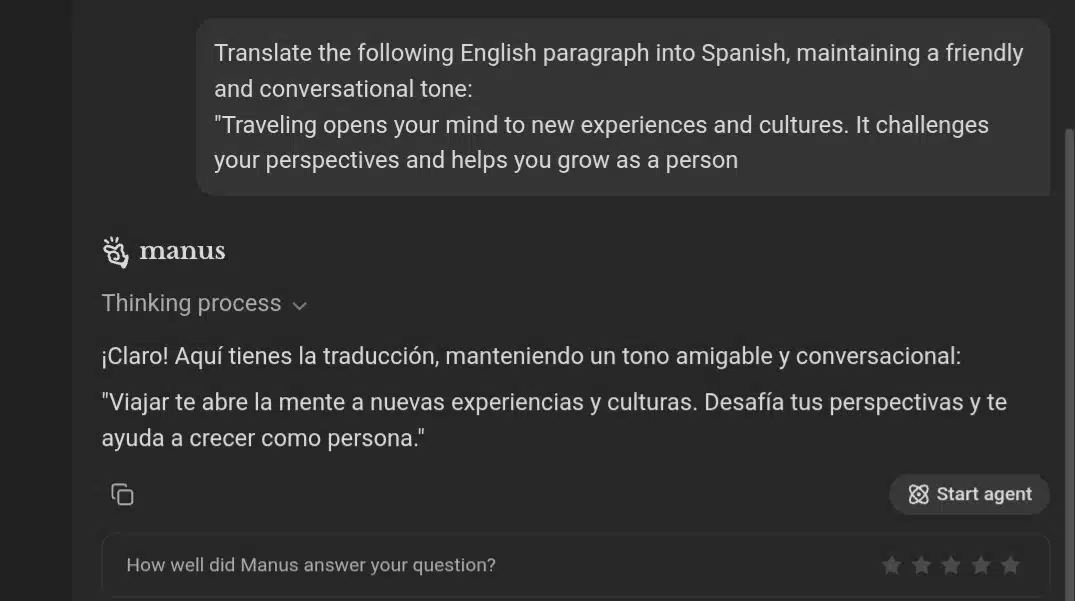
Manus delivered a smooth and natural Spanish translation. It used phrases like “Viajar abre tu mente a nuevas experiencias y culturas,” which feels warm and conversational. The sentence structure flowed well, and Manus avoided overly literal phrasing. It kept the tone approachable, using “tu” to maintain a personal and friendly voice that suits casual readers.
Deepseek output
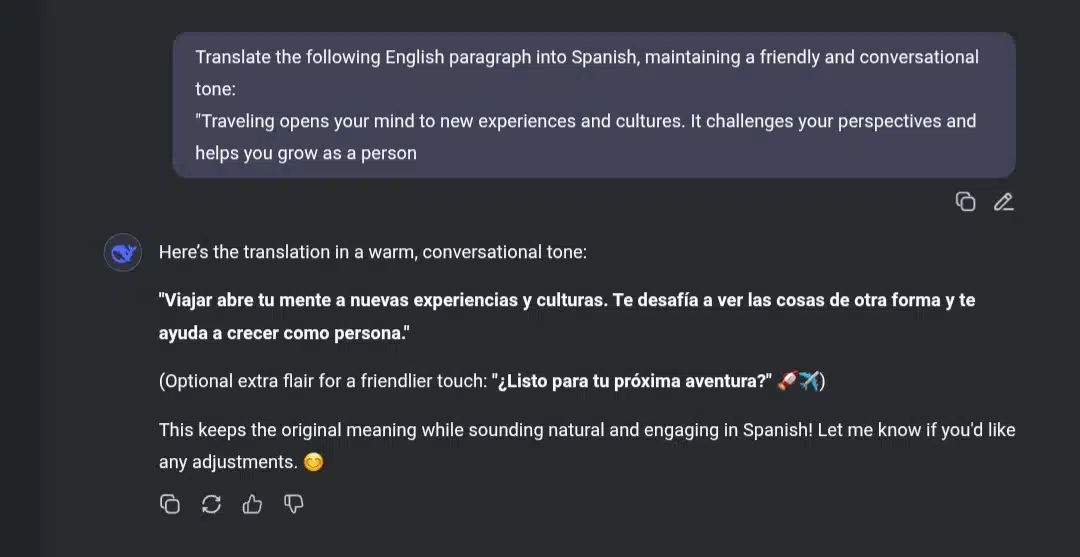
Deepseek’s translation was accurate and grammatically correct but leaned toward a more formal tone. It translated the paragraph as “Viajar amplía su mente a nuevas experiencias y culturas,” which is correct but less personal due to the use of “su.” Some phrases were translated literally, which made the text feel a bit more rigid. Still, the clarity and correctness were strong points.
In terms of editing, Manus made it easy to adjust tone, while Deepseek offered useful synonym suggestions but was less intuitive for style changes.
Verdict
Manus created a friendlier, more conversational Spanish translation, while Deepseek’s version was precise and formal, better suited for professional or academic contexts.
Task 7: research assistance (extracting key insights)
Prompt: Given the following paragraph, extract the three most important points clearly and concisely:
“Climate change is accelerating at an unprecedented rate, causing extreme weather events worldwide. Rising global temperatures contribute to melting ice caps and sea-level rise, threatening coastal communities. Efforts to reduce carbon emissions and transition to renewable energy sources are critical to slowing these impacts.”
This task evaluates how Manus and Deepseek handle information extraction and summarization—key features for users who rely on AI to sift through research material.
Manus output
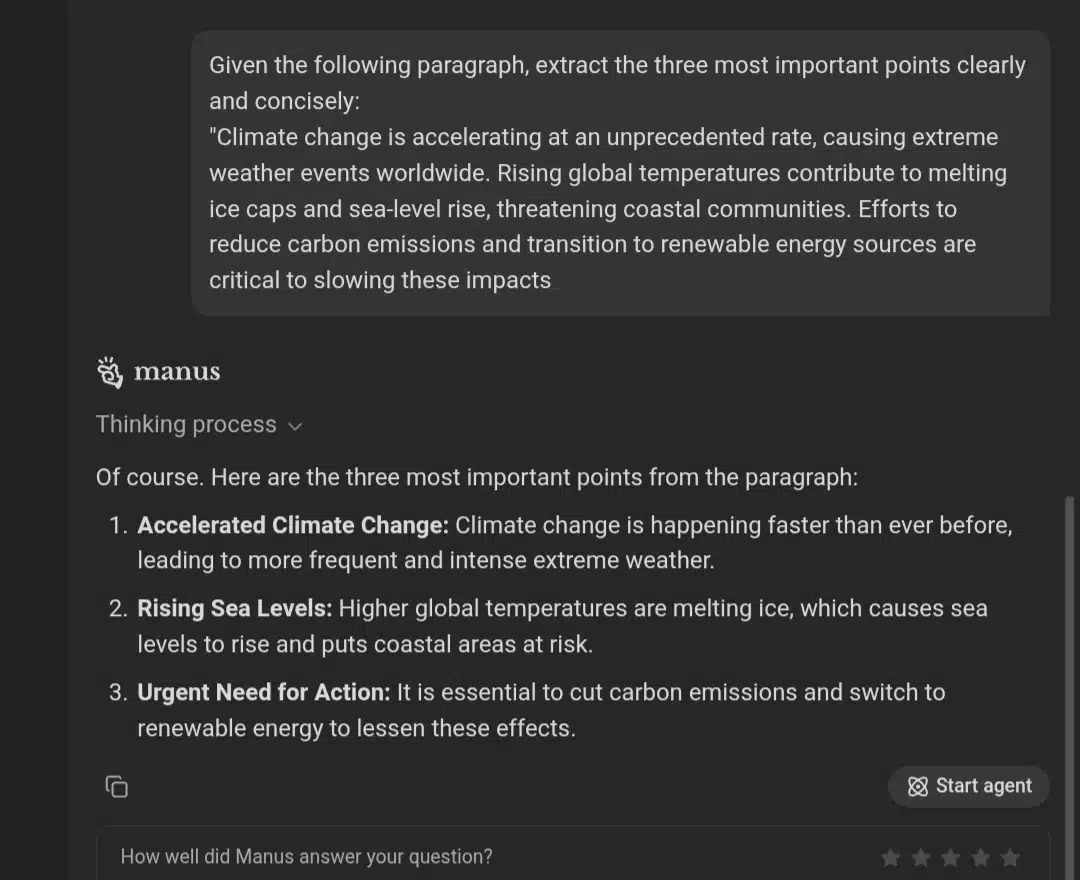
Manus identified the key points accurately: the acceleration of climate change and extreme weather, the threat posed by melting ice caps and sea-level rise, and the importance of reducing carbon emissions through renewable energy. The points were presented clearly but in somewhat generic phrasing without much elaboration.
Deepseek output
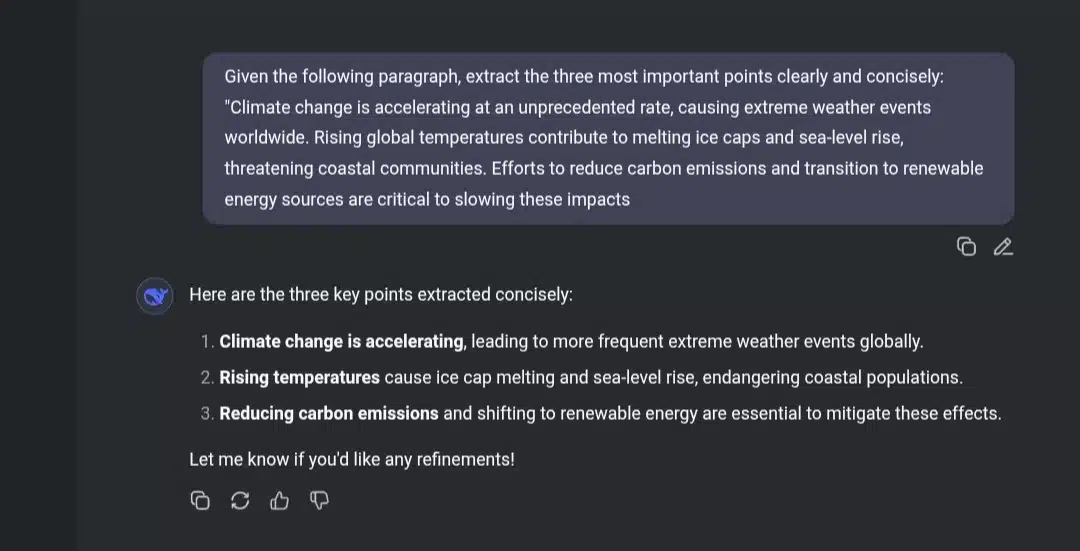
Deepseek’s extraction was similarly accurate but added slightly more context, mentioning “threatening coastal communities” explicitly as a separate point. The phrasing was concise and precise, making the insights easy to grasp quickly.
In terms of usability, Manus provided the key points in a neat list, making it easy to copy and use. Deepseek’s interface offered quick toggles to expand or collapse details, aiding deeper exploration if needed.
Verdict
Both tools performed well in extracting key insights, but Deepseek’s added contextual detail and flexible interface gave it a slight edge for research-focused users.
Research and fact-checking support
When it comes to supporting content accuracy and reliability, Manus and Deepseek take notably different approaches.
Manus primarily relies on its trained language models, which are based on extensive datasets but do not access live or updated data during content generation. This means that while Manus can produce well-informed text, it may not always reflect the most recent facts or developments. Its fact-checking features are mostly based on internal consistency and language quality rather than real-time verification.
Deepseek, however, stands out by integrating real-time data retrieval and semantic search technology into its workflow. This allows users to pull in current, relevant information from live sources as they write. Deepseek’s fact-checking tools actively highlight claims and offer source references, making it easier to ensure accuracy, especially for research-heavy or technical content.
In practice, this means Deepseek is better suited for users who need up-to-date and verifiable content, such as journalists, academics, or technical writers. Manus, on the other hand, works well for general content creation where speed and tone matter more than the latest facts.
Both platforms present fact-checking information differently: Manus offers suggestions to improve factual clarity within the text, while Deepseek provides inline references and links to sources. This makes Deepseek’s approach more transparent and useful for thorough research.
Integration, collaboration, and workflow
Beyond writing quality, how these tools fit into your daily workflow can make a big difference.
Manus offers a clean, intuitive interface designed for solo users and small teams. Its dashboard is straightforward, making it easy to input prompts, generate content, and make edits without distraction. Manus supports collaboration by allowing shared projects and simple commenting features, though these are fairly basic compared to some specialized team platforms.
On the integration front, Manus provides export options to common formats like Word and PDF, but it lacks extensive API support or plugins for deeper integration with other software. This makes it ideal for users who want an all-in-one writing assistant but don’t need complex workflows or automation.
Deepseek excels in collaboration and workflow flexibility. Its platform supports team workspaces, allowing multiple users to contribute, comment, and track changes in real time. Version control is more advanced, making it easier to manage iterative drafts and feedback.
In terms of integration, Deepseek offers APIs and plugins that connect with popular writing and publishing tools. This flexibility helps teams embed AI assistance directly into their existing workflows, from content management systems to research databases.
The user interface in Deepseek is a bit more complex due to its research features, which can have a learning curve for new users. However, this complexity pays off for teams and users who value seamless collaboration and integration.
In summary:
- If you’re a solo creator or small team looking for a simple, distraction-free writing tool, Manus’s straightforward interface and basic collaboration may be all you need.
- If you work in larger teams or need tight integration with other tools and robust collaboration features, Deepseek offers a more powerful and flexible platform.
Manus vs Deepseek: Pricing
Manus AI offers a tiered subscription model with the following plans:
- Basic: $19/month
- 1,900 credits per month
- 300 refresh credits daily
- 2 concurrent tasks
- Enhanced stability and extended context length
- Priority access during peak hours
- Plus: $39/month
- 3,900 credits per month
- 300 refresh credits daily
- 2 concurrent tasks
- Enhanced stability and extended context length
- Priority access during peak hours
- Pro: $199/month
- 19,900 credits per month
- 300 refresh credits daily
- 5 concurrent tasks
- Enhanced stability and extended context length
- Priority access during peak hours
Note: Manus operates on a credit-based system, where each task consumes a certain number of credits. Users have reported that the credits can be used up quickly, especially for complex tasks, which may lead to additional costs for heavy users.
Deepseek
DeepSeek provides a more usage-based pricing model:
- Standard Pricing:
- Input (Cache Hit): $0.07 per million tokens
- Input (Cache Miss): $0.27 per million tokens
- Output: $1.10 per million tokens
- Discounted Pricing (UTC 16:30–00:30):
- Input (Cache Hit): $0.035 per million tokens
- Input (Cache Miss): $0.135 per million tokens
- Output: $0.550 per million tokens
Note: DeepSeek’s pricing is based on token usage, which can be more cost-effective for users with variable or high-volume needs.
Final verdict: who should use which tool?
Manus and Deepseek both bring strong AI writing capabilities, but serve different needs.
Choose Manus if you want a straightforward, user-friendly writing assistant that delivers natural, polished content quickly. It’s ideal for solo creators and small teams focused on content creation without heavy research demands.
Pick Deepseek if you need robust research and fact-checking features, real-time data integration, and advanced collaboration tools. It’s a better fit for professionals who require accuracy, up-to-date information, and seamless workflow integration.
Pricing-wise, Manus’s credit-based system works if your usage is consistent, while Deepseek’s token-based pricing may be more cost-effective for varied or large-volume users.
Ultimately, your choice depends on whether you prioritize ease of use and content flow (Manus) or research depth and flexibility (Deepseek).
Wrapping up
Both Manus and Deepseek offer powerful AI tools that can boost your writing in different ways. Manus woods with its ease of use and smooth, natural writing. That is perfect for quick, engaging content. Deepseek stands out for its research capabilities and collaboration features, making it a strong choice for detail-oriented and team-based projects.
Whichever tool fits your style and needs, testing them out yourself will give you the best sense of what works. Hopefully, this comparison has helped clarify what each brings to the table.
If you’ve tried either Manus or Deepseek, I’d love to hear your thoughts. Drop a comment or reach out to share your experience!
You may also like :
| chatGPT vs Claude for coding | chatGPT vs Perplexity AI: 10 use cases |
| Grok 3 vs ChatGPT: 10 prompts | Meta AI vs ChatGPT |
| Bing AI vs ChatGPT | Deepseek AI review |

